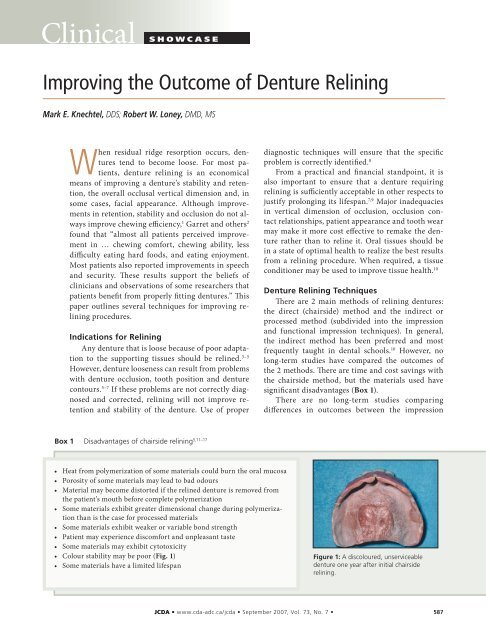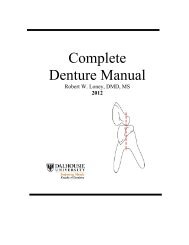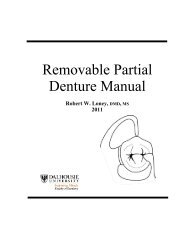Improving The Outcome Of Denture Relining - Removable ...
Improving The Outcome Of Denture Relining - Removable ...
Improving The Outcome Of Denture Relining - Removable ...
Create successful ePaper yourself
Turn your PDF publications into a flip-book with our unique Google optimized e-Paper software.
Clinical s<br />
h o w c a s e<br />
<strong>Improving</strong> the <strong>Outcome</strong> of <strong>Denture</strong> <strong>Relining</strong><br />
Mark E. Knechtel, DDS; Robert W. Loney, DMD, MS<br />
When residual ridge resorption occurs, dentures<br />
tend to become loose. For most patients,<br />
denture relining is an economical<br />
means of improving a denture’s stability and retention,<br />
the overall occlusal vertical dimension and, in<br />
some cases, facial appearance. Although improvements<br />
in retention, stability and occlusion do not always<br />
improve chewing efficiency, 1 Garret and others 2<br />
found that “almost all patients perceived improvement<br />
in … chewing comfort, chewing ability, less<br />
difficulty eating hard foods, and eating enjoyment.<br />
Most patients also reported improvements in speech<br />
and security. <strong>The</strong>se results support the beliefs of<br />
clinicians and observations of some researchers that<br />
patients benefit from properly fitting dentures.” This<br />
paper outlines several techniques for improving relining<br />
procedures.<br />
Indications for <strong>Relining</strong><br />
Any denture that is loose because of poor adaptation<br />
to the supporting tissues should be relined. 3–5<br />
However, denture looseness can result from problems<br />
with denture occlusion, tooth position and denture<br />
contours. 5–7 If these problems are not correctly diagnosed<br />
and corrected, relining will not improve retention<br />
and stability of the denture. Use of proper<br />
diagnostic techniques will ensure that the specific<br />
problem is correctly identified. 8<br />
From a practical and financial standpoint, it is<br />
also important to ensure that a denture requiring<br />
relining is sufficiently acceptable in other respects to<br />
justify prolonging its lifespan. 7,9 Major inadequacies<br />
in vertical dimension of occlusion, occlusion contact<br />
relationships, patient appearance and tooth wear<br />
may make it more cost effective to remake the denture<br />
rather than to reline it. Oral tissues should be<br />
in a state of optimal health to realize the best results<br />
from a relining procedure. When required, a tissue<br />
conditioner may be used to improve tissue health. 10<br />
<strong>Denture</strong> <strong>Relining</strong> Techniques<br />
<strong>The</strong>re are 2 main methods of relining dentures:<br />
the direct (chairside) method and the indirect or<br />
processed method (subdivided into the impression<br />
and functional impression techniques). In general,<br />
the indirect method has been preferred and most<br />
frequently taught in dental schools. 10 However, no<br />
long-term studies have compared the outcomes of<br />
the 2 methods. <strong>The</strong>re are time and cost savings with<br />
the chairside method, but the materials used have<br />
significant disadvantages (Box 1).<br />
<strong>The</strong>re are no long-term studies comparing<br />
differences in outcomes between the impression<br />
Box 1 Disadvantages of chairside relining 5,11–17<br />
• Heat from polymerization of some materials could burn the oral mucosa<br />
• Porosity of some materials may lead to bad odours<br />
• Material may become distorted if the relined denture is removed from<br />
the patient’s mouth before complete polymerization<br />
• Some materials exhibit greater dimensional change during polymerization<br />
than is the case for processed materials<br />
• Some materials exhibit weaker or variable bond strength<br />
• Patient may experience discomfort and unpleasant taste<br />
• Some materials may exhibit cytotoxicity<br />
• Colour stability may be poor (Fig. 1)<br />
• Some materials have a limited lifespan<br />
Figure 1: A discoloured, unserviceable<br />
denture one year after initial chairside<br />
relining.<br />
www.cda-adc.ca/jcda • September 2007, Vol. 73, No. 7 • 587
–––– Clinical Showcase ––––<br />
Figure 2: <strong>Denture</strong> positioning errors. (a) Pre-impression relationship of teeth,<br />
denture base and tissues. <strong>The</strong> red line indicates the horizontal plane through the<br />
original position of the incisal edge, and the green line indicates the angle of the<br />
original occlusal plane. (b) Insufficient vertical seating lengthens the incisors and<br />
positions them facially. (c) Excess relining material in the anterior region may displace<br />
the denture facially and may alter the angle of the occlusal plane. (d) Excess<br />
relining material in the posterior region may change the angle of the occlusal<br />
plane and the incisal inclination and can cause an anterior open bite.<br />
technique and the functional impression<br />
technique. No matter which relining<br />
technique is used, it is virtually<br />
impossible to place a denture filled<br />
with impression material in exactly the<br />
correct position. 18 Failure to properly<br />
position the denture in 3 dimensions<br />
can result in unwanted changes in the<br />
amount of incisal display, the degree of<br />
lip support and/or the occlusal contact<br />
relationships. <strong>The</strong> most common errors<br />
tend to be having the denture seated<br />
too far anteriorly or inferiorly when<br />
making the impression, 18 which results<br />
in an increase in vertical dimension<br />
and/or change in denture orientation<br />
(Fig. 2). <strong>The</strong>se errors can be minimized<br />
by using a low-viscosity elastomeric<br />
impression material or tissue<br />
conditioner. 18<br />
<strong>Relining</strong> Tips<br />
<strong>The</strong> following tips can help to improve the results of relining<br />
procedures, regardless of technique (Figs. 3–12).<br />
Figure 3: As the first step in a relining procedure, clean the denture.<br />
For maximal bond strength, use an ultrasonic cleaner and/or pumice<br />
and tin oxide on a rag wheel or brush to ensure that new acrylic will<br />
not be applied over calculus or plaque. A denture that may appear<br />
free of calculus when damp (at left) may exhibit residual calculus<br />
when thoroughly dried (at right).<br />
Figure 4: Failure to properly orient the denture during the<br />
impression stage of the relining procedure may cause lengthening<br />
of the incisors, increased display of gingival acrylic<br />
and a shift in the midline; see top photo. <strong>The</strong>refore, before<br />
relining, measure the vertical incisal display at rest and the<br />
occlusal vertical dimension. After the relining impression<br />
has been taken, confirm that these measurements have<br />
not changed significantly, unless a change is desired. <strong>The</strong>se<br />
measurements will help to ensure proper orientation of the<br />
denture (see bottom photo).<br />
588 www.cda-adc.ca/jcda • September 2007, Vol. 73, No. 7 •
–––– Clinical Showcase ––––<br />
Figure 5: For impression-type relining procedures,<br />
mark the centric contacts before and after taking the<br />
impression. Use one colour before taking the impression,<br />
leave the markings on the denture, and use a<br />
different colour after taking the impression. In this<br />
photograph, contacts marked before the impression<br />
(red) closely coincide or overlap with those marked<br />
after the impression (blue).<br />
Figure 6: Relieve any acrylic in the undercut areas of<br />
the base and flange so that the master cast will release<br />
easily from the denture without damage. A dental<br />
assistant in your office or staff in your laboratory can<br />
be trained to do this to expedite the relining procedure.<br />
Figure 7: Shorten any denture flanges that are too<br />
long. Special burs can be purchased to ensure even<br />
reduction of the denture. Provide room for the impression<br />
material, so that the impression does not inadvertently<br />
increase the occlusal vertical dimension. Train<br />
laboratory or auxiliary personnel to reduce the denture<br />
base to improve the efficiency of relining procedures.<br />
Figure 8: Place vent holes throughout the maxillary<br />
base to aid in seating the denture to the proper position<br />
and to prevent separation of the impression from<br />
the denture during removal from the mouth. Lower<br />
dentures rarely require such relief.<br />
www.cda-adc.ca/jcda • September 2007, Vol. 73, No. 7 • 589
–––– Clinical Showcase ––––<br />
Figure 9: A thin layer of impression material will suffice<br />
and will induce less gagging. Use a cement spatula<br />
or a #7 wax spatula to tease the material completely<br />
over the edge of the flange, to minimize voids in this<br />
area. <strong>The</strong> impression material should not completely<br />
fill the denture, but rather should follow the internal<br />
contours.<br />
Figure 10: Before the initial set, remove excess<br />
material with cotton-tipped applicators, so as to<br />
improve the contours of the impression and reduce<br />
the need for trimming. Here, a tissue conditioner<br />
used in the functional relining technique is shown,<br />
but this technique can also be used with impressiontype<br />
relining.<br />
Figure 11: To facilitate correct positioning of the<br />
denture, have an assistant help you to retract the lip<br />
so that both the anterior and the posterior vestibules<br />
can be seen simultaneously. Seat the denture until<br />
the impression material expresses over the denture<br />
flange and is visible throughout the vestibule. Have the<br />
patient tap the teeth together lightly; if the occlusion<br />
does not appear correct, modify the position of the<br />
denture. Once the occlusal contacts look acceptable,<br />
remove the mouth mirrors and lightly mould the borders<br />
of the reline impression.<br />
Figure 12: To ensure adequate retention, mark the<br />
posterior palatal seal area. If this portion of the denture<br />
is not placed properly, the relining procedure may<br />
ultimately fail, with the denture being nonretentive.<br />
590 www.cda-adc.ca/jcda • September 2007, Vol. 73, No. 7 •
–––– Clinical Showcase ––––<br />
Conclusion<br />
Once the impression phase of a relining procedure<br />
is complete, confirm the results. Trim away<br />
excess impression material, replace the denture(s),<br />
and check retention, stability and occlusion. When<br />
the relined denture is ready for delivery, treat it like<br />
a new denture, using pressure-indicating paste, articulating<br />
paper and other suitable tools. Finally,<br />
take the time to remount the denture. <strong>The</strong>re is<br />
good evidence that this procedure will ultimately<br />
save time, as it decreases the need for future appointments<br />
to eliminate sore spots. 19 a<br />
THE AUTHORS<br />
Dr. Knechtel is instructor and head, division of<br />
patient and community care, faculty of dentistry,<br />
Dalhousie University, Halifax, Nova Scotia.<br />
Dr. Loney is professor and head, division of<br />
removable prosthodontics, faculty of dentistry,<br />
Dalhousie University, Halifax, Nova Scotia.<br />
Correspondence to: Dr. Mark E. Knechtel, Division of Patient and<br />
Community Care, Faculty of Dentistry, Dalhousie University, 5981<br />
University Ave., Halifax, NS B3H 1W2. Email: mr674907@dal.ca.<br />
<strong>The</strong> authors have no declared financial interests.<br />
References<br />
1. Perez P, Kapur KK, Garrett NR. Studies of biologic parameters for<br />
denture design. Part III: Effects of occlusal adjustment, base retention,<br />
and fit on masseter muscle activity and masticatory performance.<br />
J Prosthet Dent 1985; 53(1):69–73.<br />
2. Garrett NR, Kapur KK, Perez P. Effects of improvements of<br />
poorly fitting dentures and new dentures on patient satisfaction.<br />
J Prosthet Dent 1996; 76(4):403–13.<br />
3. Barco MT, Moore BK, Swartz ML, Boone ME, Dykema RW, Phillips<br />
RW. <strong>The</strong> effect of relining on the accuracy and stability of maxillary<br />
complete dentures — an in vitro and in vivo study. J Prosthet Dent<br />
1979; 42(1):17–22.<br />
4. Christensen GJ. <strong>Relining</strong>, rebasing partial and complete dentures.<br />
J Am Dent Assoc 1995; 126(4):503–6.<br />
5. Zarb GA, Jacob R. Prolonging the useful life of complete<br />
dentures: the relining procedure. In: Zarb GA, Bolender CL,<br />
editors. Prosthodontic treatment for edentulous patients: complete<br />
dentures and implant-supported prostheses. St. Louis: Mosby;<br />
2003. p. 471–80.<br />
6. Grant AA, Heath JR, McCord JF. Complete prosthodontics: problems,<br />
diagnosis and management. London: Wolfe; 1994. p. 56–67.<br />
7. Christensen FT. <strong>Relining</strong> techniques for complete dentures.<br />
J Prosthet Dent 1971; 26(4):373–81.<br />
8. Loney R. Diagnosing denture pain: principles and practice.<br />
J Can Dent Assoc 2006; 72(2):137–41.<br />
9. Levin B. A reliable reline-rebase technique. J Prosthet Dent 1976;<br />
36(2):219–25.<br />
10. Nassif J, Jumbelic R. Current concepts for relining complete<br />
dentures: a survey. J Prosthet Dent 1984; 51(1):11–5.<br />
11. Arena CA, Evans DB, Hilton TJ. A comparison of bond strengths<br />
among chairside hard reline materials. J Prosthet Dent 1993;<br />
70(2):126–31.<br />
12. Wyatt CC, Harrop TJ, MacEntee MI. A comparison of physical<br />
characteristics of six hard denture reline materials. J Prosthet Dent<br />
1986; 55(3):343–6.<br />
13. Cucci AL, Giampaolo ET, Leonardi P, Vergani CE. Unrestricted<br />
linear dimensional changes of two hard chairside reline resins and<br />
one heat-curing acrylic resin. J Prosthet Dent 1996; 76(4):414–7.<br />
14. Mutluay MM, Ruyter IE. Evaluation of adhesion of chairside<br />
hard relining materials to denture base polymers. J Prosthet Dent<br />
2005; 94(5):445–52.<br />
15. Curtis DA, Eggleston TL, Marshall SJ, Watanabe LG. Shear bond<br />
strength of visible-light-cured resin relative to heat-cured resin.<br />
Dent Mater 1989; 5(5):314–8.<br />
16. Campanha NH, Pavarina AC, Giampaolo ET, Machado AL,<br />
Carlos IZ, Vergani CE. Cytotoxicity of hard chairside reline resins:<br />
effect of microwave irradiation and water bath postpolymerization<br />
treatments. Int J Prosthodont 2006; 19(2):195–201.<br />
17. Haywood J, Basker RM, Watson CJ, Wood DJ. A comparison of<br />
three hard chairside denture reline materials. Part I. Clinical evaluation.<br />
Eur J Prosthodont Restorat Dent 2003; 11(4):157–63.<br />
18. Javid NS, Michael CG, Mohammed HA, Colaizzi FA. Threedimensional<br />
analysis of maxillary denture displacement during<br />
reline impression procedure. J Prosthet Dent 1985; 54(2):232–7.<br />
19. Firtell DN, Finzen FC, Holmes JB. <strong>The</strong> effect of clinical remount<br />
procedures on the comfort and success of complete dentures.<br />
J Prosthet Dent 1987; 57(1):53–7.<br />
www.cda-adc.ca/jcda • September 2007, Vol. 73, No. 7 • 591















